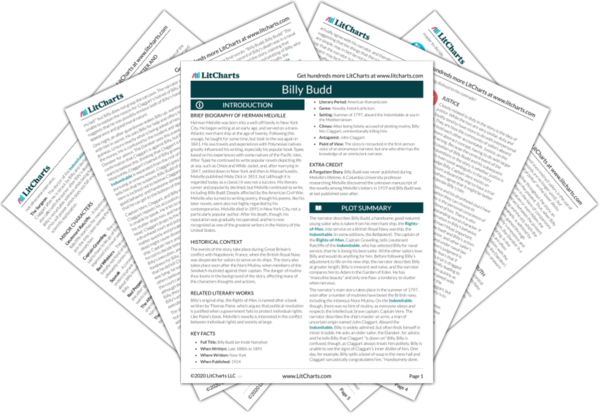Summary
Analysis
The narrator describes how Billy looked even younger than his age, with an almost feminine face. His transition from a merchant ship to a large warship was like that of a "rustic beauty" brought from the countryside to compete with "the highborn dames of the court." But Billy was not aware of how out of place he was, and was not aware of the "ambiguous smile" he provoked among some sailors.
The strong male camaraderie between Melville's sailors, centered as it is around the beauty of Billy, is so intense that it approaches a kind of erotic attachment, as Billy is repeatedly compared to beautiful women.
Themes
The narrator compares Billy to classical Greek sculpture, though he notes there was another quality in his appearance. An officer on the ship once asked his place of birth and father, and Billy said he didn't know—he was found in a basket on a doorstep in Bristol. The narrator claims that Billy clearly had a noble lineage, as his appearance proved.
The comparison to ancient statuary emphasizes Billy's beauty and associates him with a glorious, idealized innocent ancient past. The narrator (who should not be confused with Melville, who surely has more complicated beliefs) believes that Billy's appearance is proof of his noble character.
Themes
The narrator continues to describe Billy, who was intelligent but illiterate. Not at all self-conscious, he was an "upright barbarian," like Adam in the garden of Eden before the Fall. Indeed, the narrator elaborates, good character often appears naturally in men, not from the influence of civilization or convention.
According to the narrator, Billy had "masculine beauty" but did have one flaw, just like "the beautiful woman in one of Hawthorne's minor tales." In moments of peril, he would sometimes stutter. The narrator says that this flaw should prove that Billy is a realistic hero, not a figure from some fantastical romance.
The narrator stresses that his story is true, as proven by Billy's one flaw. This insistence on truthfulness has an interesting affect. On one hand, it emphasizes the fact that the story isn't true—it's a fiction made up by Melville! But it also separates Melville from his narrator. Melville made up the story, but the narrator lives in the same world as the characters Melville has made up. The narrator is a character in the story who exists at the same level as the characters, and this makes the narrator's story of these true events unreliable, because why should we assume that the narrator absolutely knows what happened any more than anyone else does. The narrator is creating a coherent narrative based on his speculations regarding these "true" events (just like a historian does). And that is the "history" we are reading. And you as reader can take the narrator's story at face value. But you can also question the narrator's accuracy or knowledge, just as historians disagree. That the story can exist on these multiple levels of accuracy and unreliability at the same time is part of Melville's triumph in writing it.
Themes
Literary Devices
Get the entire Billy Budd LitChart as a printable PDF.













